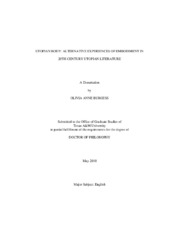| dc.description.abstract | Utopian literature has typically viewed the body as a pitfall on the path to social
perfectibility, and utopian planners envision societies where the troublesome body is
distanced as much as possible from utopia's guiding force-Reason. However, after two
world wars, the failure of communism, and a century of corrupt "utopian" projects like
Hitler's social engineering, dystopian societies justified on the grounds of "rational
planning" fail to convince us, and the body has risen as the new locus for identity and
agency, a point of stability in a dangerous and unstable environment. In this dissertation,
I argue that utopian literature in the late twentieth century has identified the body as key
to imagining new alternatives and re-connecting with an increasingly jeopardized sense
of immediate, embodied experience. Protagonists in utopian literature looking to escape
dehumanizing and bureaucratic worlds find their loophole in the sensual rush of
adrenaline and instinct and the jarring rejuvenation of nerve and muscle, experiences
which are much more immediately real and trustworthy than the tenuous dictates of
institutions that tumble easily into absurdity and terror. Survival necessitates a raw and transformed identity that transgresses the tightly regimented boundaries of civilization
and embraces the tumultuous chaos of the fringes and countercultures. Here, utopia
thrives.
I ground this study in theoretical and sociological texts which recognize the
centrality of the body in society and the dynamic potentiality of utopian thinking, and
then examine how these developments unfold in utopian literature since the mid twentieth
century. The body as utopia surfaces in a variety of ways: as the longing for
movement in Kurt Vonnegut's Player Piano; as the creation of alternative spaces
defined by embodiment in Angela Carter's Heroes and Villains and Chuck Palahniuk's
Fight Club; as the exuberant immersion in the modified body in Chuck Palahniuk's
Rant; and as the search for perfection in a detached and corporate world in Margaret
Atwood's Oryx and Crake. I conclude with an assessment of utopia in the twenty-first
century, referring to Cormac McCarthy's The Road as a barometer of the grim state of
utopian possibility as we head into the next century. | en |


